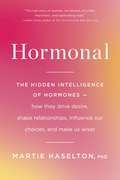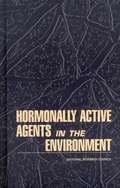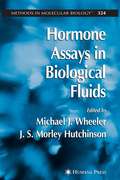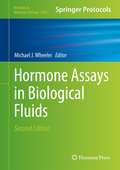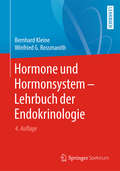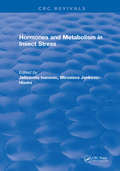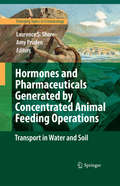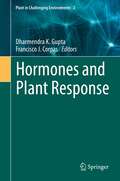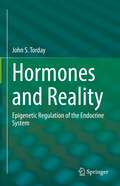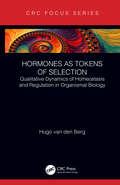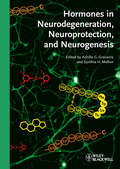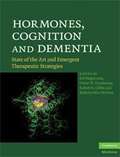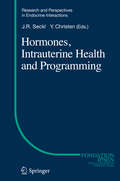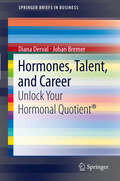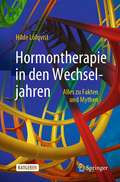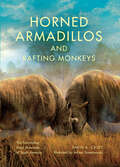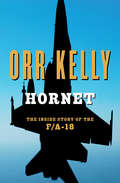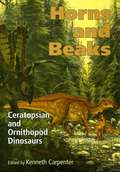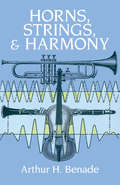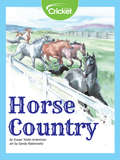- Table View
- List View
Hormonal: The Hidden Intelligence of Hormones -- How They Drive Desire, Shape Relationships, Influence Our Choices, and Make Us Wiser
by Martie HaseltonThe hidden intelligence of hormones and their role in empowering women to succeed sexually, reproductively, and socially.Did you know women walk more, eat less, socialize more, meet more men, dance more, and flirt more when they're ovulating? Or that PMS may have evolved to get rid of boyfriends with unfit sperm? Behind the "fickle" differences in what women find sexy about men, or what they like to wear, there's a hidden adaptive intelligence that has been shaped over eons. In this provocative and paradigm-shattering book, Martie Haselton, the world's leading researcher on sexuality and the ovulation cycle, takes a deep, revealing look at the biological processes that so profoundly influence our behavior and sets forth a radical new understanding of women's bodies, minds, and sexual relationships, one that embraces hormonal cycles as adaptive solutions to genuine biological challenges. At the core of Hasleton's new Darwinian feminism is her remarkable discovery that humans, like our animal cousins, possess a special phase of sexuality, called estrus, which comes with a host of physiological and behavioral changes.Rigorously researched, entertaining, and empowering, Hormonal offers women deep new insights into their bodies, brains, relationships, and affairs, allowing them to make better-informed choices about sex, marriage, friendship, contraception, and more. Above all, Hormonal is a clarion call to appreciate and embrace the genius of female biology.
Hormonally Active Agents in the Environment
by National Research CouncilSome investigators have hypothesized that estrogens and other hormonally active agents found in the environment might be involved in breast cancer increases and sperm count declines in humans as well as deformities and reproductive problems seen in wildlife.This book looks in detail at the science behind the ominous prospect of "estrogen mimics" threatening health and well-being, from the level of ecosystems and populations to individual people and animals. The committee identifies research needs and offers specific recommendations to decisionmakers.This authoritative volume: Critically evaluates the literature on hormonally active agents in the environment and identifies known and suspected toxicologic mechanisms and effects of fish, wildlife, and humans.Examines whether and how exposure to hormonally active agents occurs--in diet, in pharmaceuticals, from industrial releases into the environment--and why the debate centers on estrogens.Identifies significant uncertainties, limitations of knowledge, and weaknesses in the scientific literature. The book presents a wealth of information and investigates a wide range of examples across the spectrum of life that might be related to these agents.
Hormone Assays in Biological Fluids
by J. S. Hutchinson William D. Fraser Michael J. WheelerExpert researchers who have developed and applied significant new assays describe in step-by-step detail a variety of methods for measuring a broad variety of hormones, related peptides, and synthetic steroids in various biological fluids. The hormones measured range from glucocorticoids in biological fluids, urinary steroids, aldosterone in blood, and plasma renin activity, to gut hormones in plasma, melatonin, prolactin, 6-sulfatoxymelatonin, and androgens in blood, saliva, and hair. The emphasis is on noncommercial assays so that investigators can set up novel methods suited to their special needs. Commercial assays are also described for comparative purposes. Tutorials on radioimmunoassay, gas chromatography-mass spectrometry, high-performance liquid chromatography, and PCR techniques help the reader to choose the best method for his or her purpose.
Hormone Assays in Biological Fluids
by Michael J. WheelerHormone measurement is necessary for the diagnosis of a wide range of clinical conditions and is essential for monitoring the effectiveness of treatment. As the number of hormone requests in the clinical field rises exponentially, it has become imperative to create hormone assays accessible to researchers with a varied range of equipment. Hormone Assays in Biological Fluids, Second Edition reviews common techniques used to measure hormones as well as relatively new methods such as tandem mass spectrometry. Additionally, subsequent chapters detail methods for a broad range of hormones; Techniques and principles covered are transferable to a wide range of substances across species. Written in the successful Methods in Molecular Biology series format, chapters include introductions to their respective topics, lists of the necessary materials and reagents, step-by-step, readily reproducible protocols, and notes on troubleshooting and avoiding known pitfalls. Authoritative and easily accessible, Hormone Assays in Biological Fluids, Second Edition will serve students, technologists, laboratory scientists, and researchers looking to apply, or attain a greater understanding of, methods for measuring hormones.
Hormone und Hormonsystem - Lehrbuch der Endokrinologie: Lehrbuch Der Endokrinologie (Springer-lehrbuch Ser.)
by Bernhard Kleine Winfried RossmanithDie technischen Fortschritte und neuen Möglichkeiten der molekularen Biologie – Genomanalysen, Expressionsanalysen, konfokale Lasermikroskopie, Proteomics – lassen die Physiologie von Wirbeltieren, genauso wie die von Nicht-Wirbeltieren, in einem neuen Licht erscheinen. Bei der Darstellung der Endokrinologie von Mensch und Tier wird dieser Entwicklung Rechnung getragen: Die Schwerpunkte liegen auf Hormonbiochemie, Hormonphysiologie, Hormonrezeptoren, endokrinen Organen und Regelkreisen und der Regelung endokriner Rhythmen. Die Betrachtung des Hormonsystems reicht von seinen Ursprüngen bei Invertebraten, seiner Evolution, den Wechselwirkungen mit Nerven- oder Immunsystem bis zu Stoffwechselstörungen bei menschlichen Gen-Defekten. Die 4. Auflage ist deutlich erweitert. Das Thema Stoffwechsel nimmt, verteilt über mehrere Kapitel, eine wesentlich größeren Raum ein. Komplett neu ist auch die Embryologie der endokrinen Organe.
Hormones and Metabolism in Insect Stress
by Jelisaveta IvanovicThis book discusses the effects of both natural (e.g., temperature, humidity, and lack of food) and man-induced stressors (e.g., pollution) on insects. Insect neurohormones and metabolism are emphasized, although all aspects of insect biology are examined. The role of ecdysteroids and juvenile hormones in response to thermal and other stressors is featured, and population studies in insect stress are presented. Entomologists, ecologists, ecophysiologists, physiologists, applied entomologists and others will find Hormones and Metabolism in Insect Stress an important reference resource.
Hormones and Pharmaceuticals Generated by Concentrated Animal Feeding Operations
by Amy Pruden Laurence S. ShoreHormones and Pharmaceuticals Generated by Concentrated Animal Feeding Operations: Transport in Water and Soil examines how hormones, antibiotics and pharmaceuticals generated from concentrated animal feeding operations (CAFOs) of cattle, poultry, swine and aquaculture are transported in water and soil. Little is known of the environmental fate of the tons of physiologically active steroid hormones released each year. In their own regard, in the last 20 years considerable attention has been given to a wide variety of natural and anthropomorphic agents known as endocrine disrupting compounds (EDCs). Until the contribution of steroid hormones to the environment are better defined, it will be difficult to quantify the exact impact of EDCs. While some advances in the understanding of the fate of these compounds in water has been made, little is known about the processes that govern their transport in soil or how they eventually reach groundwater. As this book discusses extensively, it is somewhat of a mystery how steroids, with their lipophilic nature, strong binding to humic acids and extensive metabolism by soil bacteria, can be transported through even a few centimeters of soil, let alone 20 to 40 meters to the groundwater. With respect to antibiotics, the emphasis is on their fate and transport in the environment and on the emergence of antibiotic resistant bacteria. Impacts on soil ecology, including the impact of antibiotics on the metabolism of other active agents, is also discussed. Similarly, the acaricides and insecticides used in animal husbandry are widely used and their environmental pathways have been studied and have significant impacts on soil and dung ecology. Active compounds with potential environmental impacts, such as growth promoters generated from CAFOs, are described. However, because little is known of their environmental fate, emphasis is placed on defining the gaps in our knowledge and defining their possible effects.
Hormones and Plant Response (Plant in Challenging Environments #2)
by Francisco J. Corpas Dharmendra K. GuptaThis book provides an overview of the recent advancements for plant scientists with a research focus on phytohormones and their responses (nature, occurrence, and functions) in plant cells.This book focuses on the role of phytohormones in biosynthesis, plant sexual reproduction, seed germination and fruit development and ripening. It further highlights the roles of different phytohormones on signaling pathways as well as on photoperiodism/Gravitropism/Thigmotropism.The volume also explores the role of phytohormones in gene expression and plant melatonin and serotonin and covers how plant hormones react in case of stress/defence response (metals/metalloids/pathogen). Last but not least, this volume also discusses phytohormones in the context of new regulatory molecules such as Nitric oxide, hydrogen sulfide, melatonin.
Hormones and Reality: Epigenetic Regulation of the Endocrine System
by John S. TordayCellular-molecular approach to evolution has led to radical changes in our understanding of biologic principles ranging from the Cell, to the Life Cycle, Development, Homeostasis, Senescence/Aging, Heterochrony, Pleiotropy, Phenotype, and perhaps the purpose of life itself. Much of this new way of thinking about biology and medicine emanates from experimental evidence for epigenetic inheritance. This leads one to question whether our unicellular state is the actual primary level of selection.One particular system that is now recognized as being under the auspices of epigenetic inheritance is the endocrine system, which is conventionally thought to regulate physiologic homeostasis. However, because the sex hormones play such a major role in behaviors related to the acquisition of epigenetic data, and the processing of such epigenetic data by the gonads during meiosis, their role in the evolution of the organism become tractable. The composite of the activities of the individual over the course of its lifetime can now be understood causally, resulting from the orchestration of its physiology by hormones, prenatally, postnatally and during the aging process, across the entire life span of the organism. Specific behaviors over the course of the life cycle during childhood, adolescence, puberty, adulthood and aging can now be understood mechanistically rather than merely as milestones in the various stages of life.With the above considerations in mind, this book presents the cellular-evolutionary perspective towards the relationship of the organism with its surroundings, human and non-human alike renders biology and medicine a continuum instead of fragmented, un-related anecdotes.
Hormones as Tokens of Selection: Qualitative Dynamics of Homeostasis and Regulation in Organismal Biology
by Hugo van den BergHormones as Tokens of Selection addresses deep questions in biology: How are biological systems controlled? How can one formulate general theories of homeostasis and control and instantiate such theories in mathematical models? How can one use evolutionary arguments to guide our answers to these questions, recognising that the control mechanisms themselves are a product of evolution? Biological systems are exceptionally varied and extremely difficult to understand, because they are complex and experimentation remains limited relative to the challenges at hand. Moreover, biological phenomena occur at a wide range of temporal and spatial scales. Such a deeply convoluted subject calls for a unifying and coherent theoretical foundation — one which recognises and departs from the primary importance of mathematical modelling and key physicochemical principles to theory formation in the life sciences. This Focus monograph proposes and outlines such a foundation, departing from the deceptively simple proposition that hormones are tokens of evolutionary pressures. Features Provides a coherent and unified approach to a multifaceted problem Pays close attention to both the biological and mathematical modelling aspects of the subject matter, exploring the philosophical background where appropriate Written in a concise and innovative style
Hormones in Neurodegeneration, Neuroprotection, and Neurogenesis
by Achille G. Gravanis Synthia H. MellonAs life expectancy increases and population ages, the already enormous impact of neurodegeneration on society will become even larger without better prevention and treatment. Developing strategies to prevent degeneration of neurons and to promote a healthy nervous system is, thus, critical. The development of pharmacological agents that would increase production of new neurons was recently facilitated by the identification of the hormonal regulators of various steps of adult neurogenesis. The proposed book is writen by a group of top world experts involved in the study of the mechanisms of hormonal control of brain damage and repair. The effects of thyroid and steroid hormones (estrogens, androgens, progestins, gluco-mineralo-corticoids, various neurosteroids) or polypeptide hormones (CRF, urocortins, somatostastin, GH/IGF, leptin, prolactin, PACAP, erythropoetin) on neuronal survival and neurogenesis in various neurodegenerative conditions and in brain aging will be discussed in detail. The proposed book is unique because it gives a comprehensive account of the neuroprotective and neurogenic effects of steroid and polypeptide hormones. Furthermore, new pharmacological approaches for treatment of neurodegenerative conditions are presented, based on the neuroprotective and neurogenic properties of natural and synthetic hormones.
Hormones, Cognition and Dementia: State of the Art and Emergent Therapeutic Strategies
by Eef Hogervorst Victor W. Henderson Robert B. Gibbs Roberta Diaz BrintonA decade ago, estrogen-containing hormone therapy was viewed as a promising strategy for the prevention and treatment of dementia and age-related cognitive decline. However, treatment trials in women with Alzheimer's disease showed that estrogens did not reverse cognitive impairment, and clinical trials in healthy older women indicated that estrogens did not prevent cognitive decline. The Women's Health Initiative Memory Study trial even suggested an increased risk of dementia with treatment late in life. What happened? How are we to understand these findings? What are the implications for middle-aged and older women? What about testosterone, and what about men? And where do we go from here? This book brings together world-renowned experts in basic and clinical research on sex steroids, aging, and cognition to integrate existing findings with emerging new data, and offer challenging hypotheses on these key issues.
Hormones, Intrauterine Health and Programming
by Jonathan R Seckl Yves ChristenThe authors address in particular the role of hormones and their links with other maternal environmental mediators in developmental programming. The crucial nature of the placenta as an interface and target between maternal and foetal environments is addressed. Emphasis is made on the emerging science of epigenetics as a potential explanation for how environmental events that occur during brief windows of development may exert effects that impact upon somatic cells through many rounds of mitosis for much of the life span of the subsequent organism.
Hormones, Talent, and Career: Unlock Your Hormonal Quotient®
by Diana Derval Johan BremerThe media now regularly feature breakthroughs on the influence of prenatal hormones on the brain and behavior, for instance the link to financial performance or risk management. Based on these findings and their own experiments, the authors present the Hormonal Quotient (HQ) as a scientific, holistic and reliable career management and personal development tool for professionals. Eight HQ profiles and their corresponding typical business skills and preferences are presented and enable the reader to benchmark their HQ with peers, design an ideal career plan, build a winning team in business and find the perfect work-life balance. A complimentary website allows readers to easily measure their HQ online. By the author of "The Right Sensory Mix", Berry-AMA Book Prize Finalist 2011.
Hormontherapie in den Wechseljahren: Alles zu Fakten und Mythen
by Hilde LöfqvistEs gibt viele Informationen über Wechseljahre und Hormontherapie, doch es kann oft schwierig sein, Fakten von allgemeinen Meinungen und Mythen zu unterscheiden. Dieser Ratgeber ist ein wissenschaftlich fundiertes Buch, in dem die Leserin erfährt, welche Empfehlungen zu Hormonbehandlungen es aktuell gibt und was sie tun kann, um Wechseljahresprobleme in den Griff zu bekommen. Leicht verständlich beschreibt die Autorin, eine erfahrene Gynäkologin, auf Basis eigener Erfahrungen und wissenschaftlicher Daten Hintergründe und Grundlagen der hormonellen Dysbalance. Anschaulich und lebendig zeigt ein Kapitel mit Fallbeispielen aus der Praxis der Autorin verschiedene Beschwerden und deren Behandlungsmöglichkeiten. Das Buch richtet sich hauptsächlich an Frauen im Alter rund um die Menopause, kann jedoch auch für Personen in Gesundheitsfachberufen interessant sein, die Frauen im Umgang mit hormonellen Veränderungen helfen möchten.
Horned Armadillos and Rafting Monkeys: The Fascinating Fossil Mammals of South America (Life of the Past)
by Darin A. CroftA thrilling guide to the Cenozoic mammals of South America, featuring seventy-five life reconstructions of extinct species, plus photos of specimens and sites.South America is home to some of the most distinctive mammals on Earth—giant armadillos, tiny anteaters, the world’s largest rodent, and its smallest deer. But the continent once supported a variety of other equally intriguing mammals that have no close living relatives: armored mammals with tail clubs, saber-toothed marsupials, and even a swimming sloth. We know of the existence of these peculiar species thanks to South America’s rich fossil record, which provides many glimpses of prehistoric mammals and the ecosystems in which they lived.Organized as a “walk through time” and featuring species from fifteen important fossil sites, this book is the most extensive and richly illustrated volume devoted exclusively to the Cenozoic mammals of South America. The text is supported by seventy-five life reconstructions of extinct species in their native habitats, as well as photographs of fossil specimens and the sites highlighted in the book. An annotated bibliography is included for those interested in delving into the scientific literature.“Well-written and easy for the nonspecialist to understand, this is also a most needed updating of this subject, much in the line of classic works such as Simpson’s The Beginning of the Age of Mammals in South America and Patterson and Pascual’s The Fossil Mammal Fauna of South America.” —Richard Fariña, coauthor Megafauna: Giant Beasts of Pleistocene South America“This handsome book, written by a leading expert in South American paleontology, is profusely illustrated with maps, time charts, color photographs of fossils, and exquisite life reconstructions. The book . . . will appeal to any individual, young and old alike, interested in the fossil record, as well as to students and scholars of paleontology who work in other parts of the globe.” —Choice
Hornet: The Inside Story of the F/A-18
by Orr KellyThe fascinating true story of the controversial development and deployment of the supersonic fighter jet that changed aerial warfare foreverThe McDonnell Douglas F/A-18 Hornet was born in 1978, a state-of-the-art supersonic fighter and attack aircraft with a top speed of Mach 1.8, more than one thousand miles per hour. It was versatile, fast, and reliable, and no war machine in the air could match it. The marines adopted it first, followed by the navy, impressed by its incomparable ability to engage in close aerial combat while at the same time efficiently delivering explosive payloads to designated enemy targets. It became the aircraft of choice for the US Navy&’s famous Blue Angels flight demonstration squadron in 1986 and served ably in combat from its first mission—America&’s launched air strike against Libya that same year—through 1991&’s Operation Desert Storm and well beyond. Yet the Hornet has always been shrouded in controversy, and while still in its planning stages, it sparked an unprecedented political battle that nearly doomed the miraculous machine before it could take flight.Orr Kelly, the acclaimed military author who has notably chronicled the remarkable histories of the US Navy SEALs and other branches of America&’s Special Forces, tells the fascinating true story of the F/A-18 Hornet—how it came to be, how it almost wasn&’t, and how it forever altered the way our nation&’s wars are fought.
Horns and Beaks: Ceratopsian and Ornithopod Dinosaurs
by Kenneth CarpenterHorns and Beaks completes Ken Carpenter's series on the major dinosaur types. As with his volumes on armored, carnivorous, and sauropodomorph dinosaurs, this book collects original and new information, reflecting the latest discoveries and research on these two groups of animals. The Ornithopods include Iguanodon, one of the first dinosaurs ever discovered and analyzed, and perhaps the most common and best-documented group, the hadrosaurs or "duckbilled dinosaurs." The Ceratopsians include Triceratops, known for its distinctive three-horned skull and protective collar.Contributors are Michael K. Brett-Surman, Kathleen Brill, Kenneth Carpenter, Benjamin S. Creisler, Tony DiCroce, Andrew A. Farke, Peter M. Galton, David Gilpin, Thomas M. Lehman, Nate L. Murphy, Christopher J. Ott, Gregory S. Paul, Xabier Pereda Suberbiola, Albert Prieto-Marquez, Bruce Rothschild, José Ignacio Ruiz-Omeñaca, Darren H. Tanke, Mark Thompson, David Trexler, and Jonathan R. Wagner.
Horns, Strings, and Harmony (Dover Books On Music: Acoustics)
by Arthur H. Benade"A fascinating excursion into an area too often ignored by the musical practitioner." — Music Library Association Notes.If you've ever wondered how a musical instrument produces the sound it does, this book explains the physics of musical instruments in an engaging and understandable way. Dr. Benade was a nuclear physicist, flutist, and science educator with a special ability to explain complex ideas in a simple, straightforward manner. In this book he brings that ability to bear in elucidating the ways in which music is formed by many different kinds of musical instruments.Dr. Benade first explores simple and complex vibrating systems and the ear's reception of sound. He then describes the fundamentals of the piano, violin, trumpet, bugle, trombone, oboe, clarinet, flute, saxophone, and many other instruments, demonstrating the sound-making capacities of each. For mechanically inclined readers who are interested in constructing basic instrumental models, Dr. Benade demonstrates how to build a working trumpet, flute, and clarinet.Enhanced with clear diagrams and easy scientific models, Horns, Strings, and Harmony is a book that will increase the musical enjoyment and understanding of all musicians, music lovers, and amateur scientists."The book is commended not only to the 'young person' who seeks to know some physics of musical instruments but also to those who would like to review in simple outline the basic physics of what happens within a musical instrument." — Journal of the Acoustical Society of America.
Horns, Tusks, and Flippers: The Evolution of Hoofed Mammals
by Robert M. Schoch Donald R. ProtheroSince the extinction of the dinosaurs, hoofed mammals have been the planet's dominant herbivores. Native to all continents except Australia and Antarctica, they include not only even-toed artiodactyls (pigs, hippos, camels, deer, antelopes, giraffes, sheep, goats, and cattle) and odd-toed perissodactyls (horses and rhinos), but also tethytheres (elephants and their aquatic relatives, manatees and seas cows) and cetaceans (whales and dolphins), which descended from hoofed land mammals. Recent paleontological and biological discoveries have deepened our understanding of their evolution and in some cases have made previous theories obsolete. <p><p>In Horns, Tusks, and Flippers, Donald R. Prothero and Robert M. Schoch present a compelling new evolutionary history of these remarkable creatures, combining the latest scientific evidence with the most current information about their ecology and behavior.
Horrid Henry's Crazy Creatures: A Horrid Factbook (Horrid Henry #1)
by Francesca SimonFrom multi-million-copy selling author, Francesca Simon, and David Walliams' illustrator, Tony Ross, comes the latest title in the successful Horrid Henry's Factbooks series. What's the only animal in the world to produce cube-shaped poo? What kind of lizard looks as though it has two heads? And what happens when a tarantula loses a leg?Bursting with foul facts and twisted trivia, this is the perfect guide to everything a Horrid Henry fan has ever wanted to know about animals. Gross out your family and amaze your friends with your nasty new knowledge!
Horrid Henry's Crazy Creatures: A Horrid Factbook (Horrid Henry Ser.)
by Francesca SimonFrom multi-million-copy selling author, Francesca Simon, and David Walliams' illustrator, Tony Ross, comes the latest title in the successful Horrid Henry's Factbooks series. What's the only animal in the world to produce cube-shaped poo? What kind of lizard looks as though it has two heads? And what happens when a tarantula loses a leg?Bursting with foul facts and twisted trivia, this is the perfect guide to everything a Horrid Henry fan has ever wanted to know about animals. Gross out your family and amaze your friends with your nasty new knowledge!
Horrid Henry's Space: A Horrid Factbook (Horrid Henry #1)
by Francesca SimonFrom multi-million-copy selling author Francesca Simon, and David Walliams' illustrator, Tony Ross, comes the intriguing tenth Horrid Henry's Factbook about all things outer space. What sound does the sun make? How long would it take to travel there in a car? And how do astronauts go to the toilet? Bursting with out-of-this-world facts and cosmic trivia, this is the perfect guide to everything a Horrid Henry fan has ever wanted to know about outer space, ideal for budding scientists and astronauts and Henry fanatics alike. Readers can surprise and awe their family and friends with amazing new knowledge!
Horse Country
by Susan Yoder AckermanKyle is afraid of horses, so the last thing he wants to do is go horseback riding with his Aunt Maggie. As he interacts with them and learns more about them, however, he begins to appreciate them. He learns that horses are not just pets—they can also be friends!
Horse Crazy: The Story of a Woman and a World in Love with an Animal
by Sarah Maslin NirONE OF USA TODAY'S &“20 SUMMER BOOKS YOU WON'T WANT TO MISS&” In the bestselling tradition of works by such authors as Susan Orlean and Mary Roach, a New York Times reporter and Pulitzer Prize finalist explores why so many people—including herself—are obsessed with horses.It may surprise you to learn that there are over seven million horses in America—even more than when they were the only means of transportation—and nearly two million horse owners. Acclaimed journalist and avid equestrian Sarah Maslin Nir is one of them; she began riding horses when she was just two years old and hasn&’t stopped since. Horse Crazy is a fascinating, funny, and moving love letter to these graceful animals and the people who—like her—are obsessed with them. It is also a coming-of-age story of Nir growing up an outsider within the world&’s most elite inner circles, and finding her true north in horses. Nir takes readers into the lesser-known corners of the riding world and profiles some of its most captivating figures. We meet Monty Roberts, the California trainer whose prowess earned him the nickname &“the man who listens to horses,&” and his pet deer; George and Ann Blair, who at their riding academy on a tiny island in Manhattan&’s Harlem River seek to resurrect the erased legacy of the African American cowboy; and Francesca Kelly, whose love for an Indian nobleman shaped her life&’s mission: to protect an endangered Indian breed of horse and bring them to America. Woven into these compelling character studies, Nir shares her own moving personal narrative. She details her father&’s harrowing tale of surviving the Holocaust, and describes an enchanted but deeply lonely upbringing in Manhattan, where horses became her family. She found them even in the middle of the city, in a stable disguised in an old townhouse and in Central Park, when she chased down truants as an auxiliary mounted patrol officer. And she speaks candidly of how horses have helped her overcome heartbreak and loss. Infused with heart and wit, and with each chapter named after a horse Nir has loved, Horse Crazy is an unforgettable blend of beautifully written memoir and first-rate reporting.
